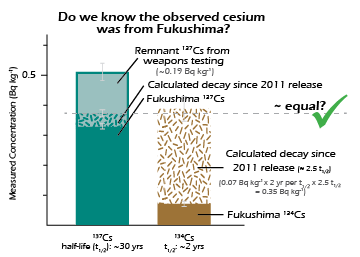Extended testing of select 2016 salmon samples has identified the Fukushima-fingerprint isotope in one sample re-measured earlier this year. The maximum level of contamination observed in a sample (134Cs: 0.07 Bq kg-1, 137Cs: 0.51 Bq kg-1) is over 1,700 times lower than the Health Canada Action Level (1,000 Bq kg-1) and is not known to be a health risk for either humans or the environment.
These results are an update to the 2016 biotic monitoring efforts where nine salmon samples (of the 123 collected) were selected for extended, 2 week testing, after the 6 hour initial analysis detected trace concentrations of cesium-137 (137Cs, half-life ≈ 30 years). The extended detection time results in a more precise measure of 137Cs and an increased chance of detecting cesium-134 (134Cs, half-life ≈ 2 years), the Fukushima fingerprint isotope. This longer analysis is similar to increasing the exposure time on a camera in low light conditions to enhance the image details and is the same procedure that allowed us to detect 134Cs in one sample in 2015. The results from this analysis confirmed low levels of 137Cs in all 9 samples and detected 134Cs in one sample. That sample was from one pink salmon (Oncorhynchus gorbuscha) from the Nass River on the northern coast of British Columbia.


Cesium-137 is more readily detected in salmon, and the environment, in part due to the 30 year half-life of this isotope. This half-life length means that it is still in detectable quantities from atmospheric testing of nuclear weapons and the 1986 Chernobyl disaster in addition to the quantities released from Fukushima. However, the 2 year half-life of 134Cs means that it is essentially only present in the environment due to the Fukushima disaster as all other sources have decayed away. In 2016, when these fish were collected, five years had passed since the disaster which means that only about 18% of the original 134Cs released remains in the environment. Mathematically, we can correct for this decay to check if our observations from this pink salmon make sense since we know that 137Cs and 134Cs were released from the disaster in roughly equal quantities.

To compare the health impact of the cesium concentrations to that of the naturally occurring radionuclides in the environment, we need to convert these measurements to the effective dose. This is calculated by factoring in the exposure (the average Canadian eats about 8.8 kg of seafood annually) and using a conversion factor called the dose coefficient recommended by the International Commission on Radiological Protection. Once converted, we may compare like apples to apples.
The total dose that would be ingested in a year’s supply of salmon, assuming all had the contamination of this one fish, would be 6.62 μSv. Of that, 99% of the dose (6.55 μSv) is due to the naturally present levels of polonium-210 while cesium contributes just 1% of the dose (0.09 μSv). Considering the hundreds of fish InFORM has analyzed from various west coast rivers, this dose for Fukushima-derived contamination represents a very good estimate of the maximum dose present. This estimate is valid for all Pacific salmon consumed in Canada from 2016.

Polonium-210 (210Po, half-life: 138 days) is part of the natural decay series of uranium-238. Uranium is naturally present in seawater with primordial origins from early Earth. 210Po is known from previous research to be the main contributor to the dose that can be attributed to the consumption of salmon or seafood. This is why InFORM scientist, Dr. Jing Chen of Health Canada’s Radiation Protection Bureau, has been investigating the variability of this isotope in BC and Yukon salmon since InFORM monitoring began in 2013. Levels of 210Po in this fish are consistent with other results from her study, which will be featured in an upcoming post.
Seafood is just one source of the normal background radiation dose that everyone alive receives in a year. Radiation is present in the food we eat, water we drink, in the air we breathe, and bombarding us from the cosmos above. The ingested radiation dose from cesium and polonium in BC salmon is small fraction of the worldwide average annual effective dose from exposure to natural background radiation (2400 µSv per year).
So, rest easy the next time you wish to enjoy seafood. It continues to be a healthy component of the normal diet. Bon appétit!
Acknowledgements and Data
Salmon samples are provided to the InFORM project from our numerous partners at First Nations across BC and Yukon which donate from their subsistence fishery and Fisheries and Oceans Canada hatcheries. The salmon from the Nass River were donated from the Nisga’a Nation near Prince Rupert.
To view the full results from all 123 salmon from 2016 that were part of our biotic monitoring effort, see our earlier summary or Open Data Canada.
Photo credit: Eiko Jones Photography

